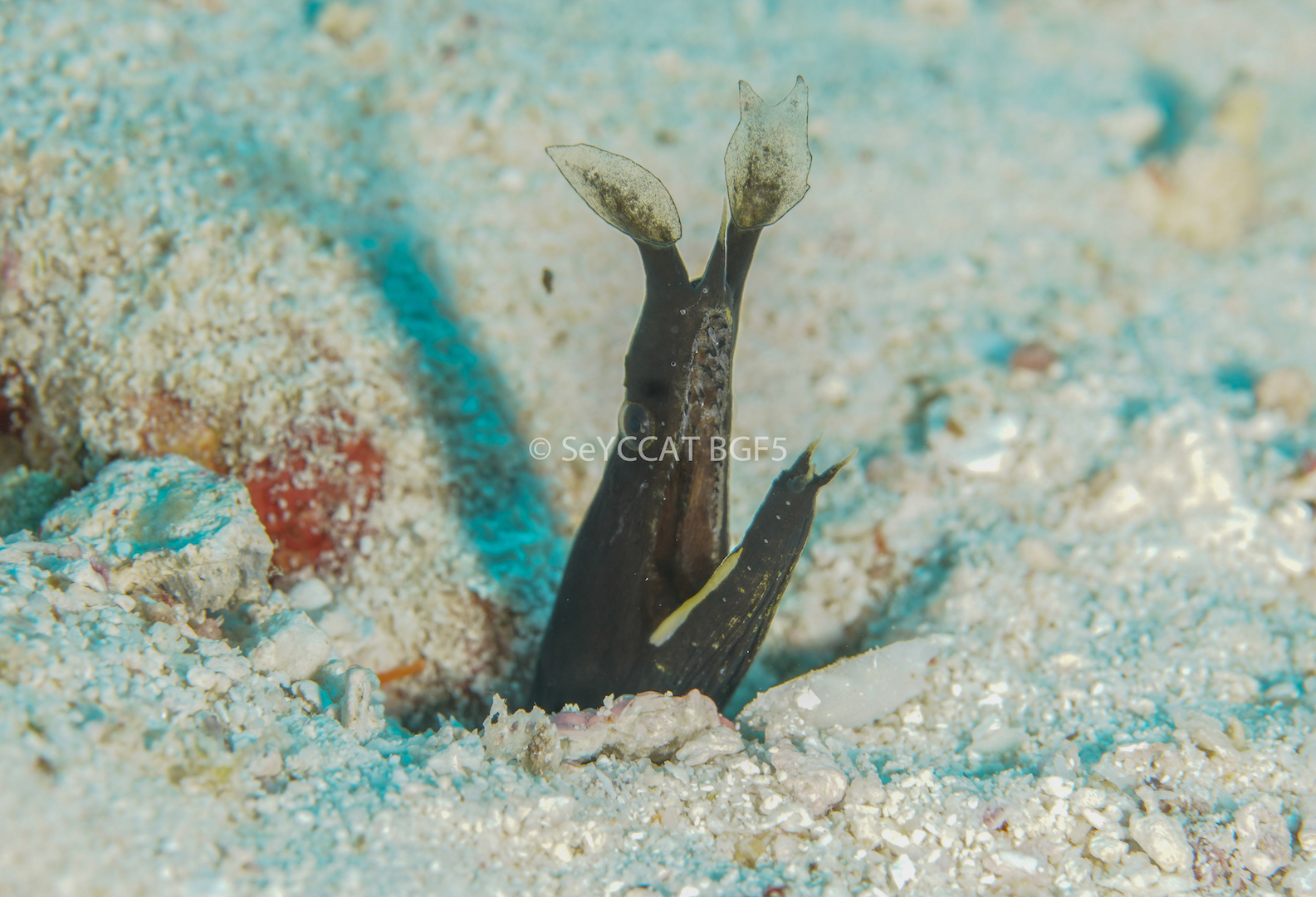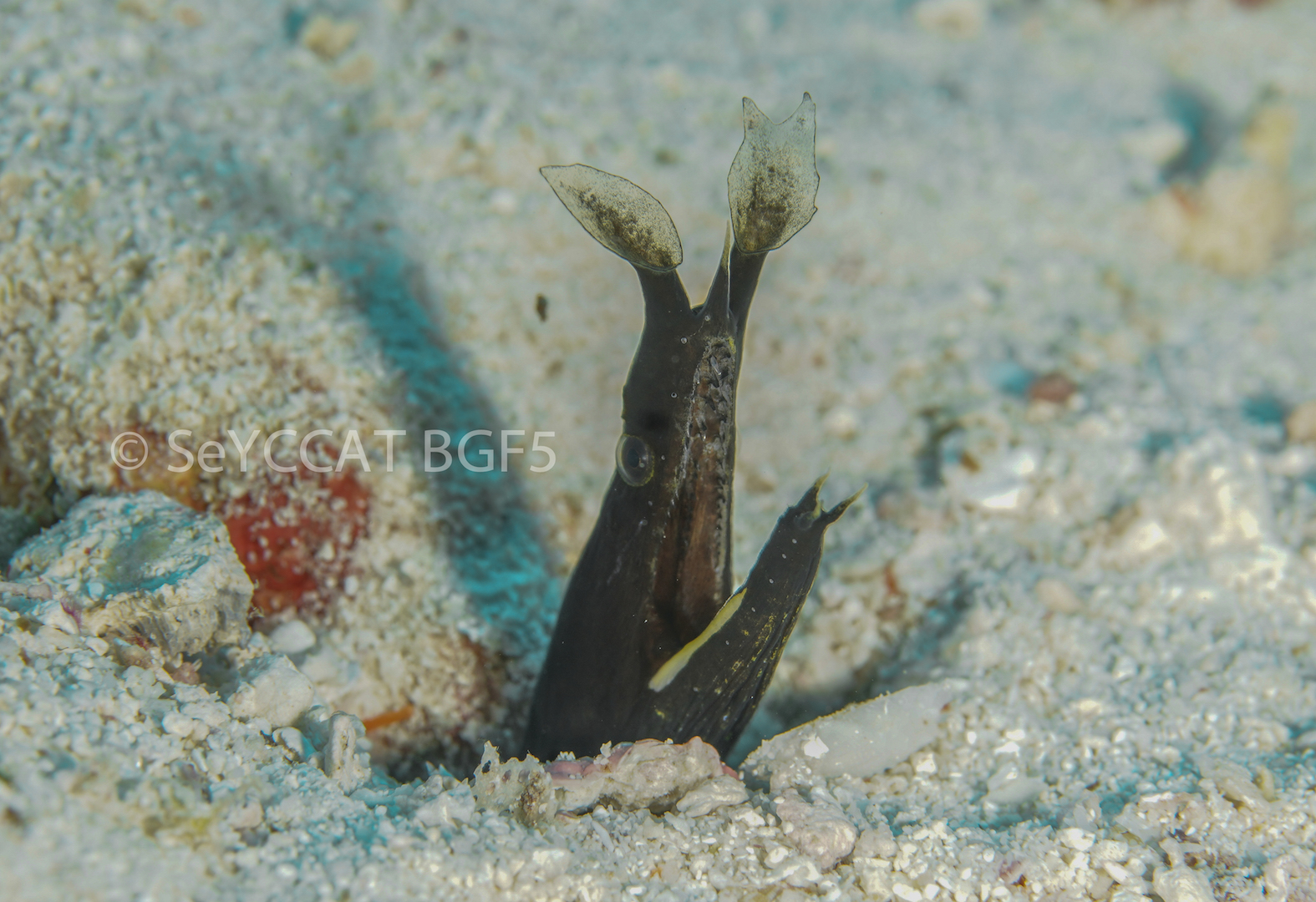Description:
Dorsal spines: 0; Dorsal rays: 0; Anal spines: 0; Anal rays: 0.
Body long, compressed, very slender, ribbon-like body. Tubular anterior nostrils ending in fan-like extensions. Three fleshy tentacles on tip of lower jaw
and a single fleshy pointed projection at the tip of its snout. Intermaxillary teeth in three rows, with teeth on the jaws conical, staggered and similar
in size. Vertebrae: 270 - 286.
Colour: Colouration varies with growth and sexual condition. Juveniles and sub-adults black, developing a yellow dorsal fin with white margin. Yellowish
stripe on mandible in juveniles. Adult males bright blue with snout and lower jaw yellow. Adult females are yellow with black anal fin and sometimes
bluish posterior colouration.
Size:
Maturity: range 94 – 120 cm. Max length: 130 cm TL.
Habitat and Ecology:
Inhabits lagoons and seaward reefs (depth 1–67 m). Secretive, normally hidden in sand or rubble with its head protruding. Feeds on small fishes.
Tends to be site attached; individuals have been known to stay in the same hole for months or even years.
Only moray that undergoes abrupt changes in coloration and sex. It is a protandrous hermaphrodite, i.e., all females are derived from males that have
changed sex.
Fishery Status:
This species is not protected or subject to fishery regulations. It is not subject to the artisanal fishery.
Notes:
Photo courtesy Eleanor Brighton and Chris Mason-Parker (c) 2022 Blue Safari Seychelles/Marine Conservation Society, Seychelles. Juvenile pictured.
Photograph taken at Alphonse group 2022.
Rhinomuraena quaesita has several characteristics that have lead experts to suggest that it should be placed in its own family — the Rhinomuraenidae;
these include the positioning of its kidneys and most of its reproductive organs posterior to the anus (a unique condition that has not been reported in
any other vertebrate).
References:
Bray, B.J. Rhinomuraena quaesita in Fishes of Australia, https://fishesofaustralia.net.au/home/species/3568 (29/06/23).
Chen, H-M. et al. (1994). A Review of the Muraenid Eels (Family Muraenidae) from Taiwan with Descriptions of Twelve New Records. Zoological Studies 33(1) 44-64 (1994).
Froese, R. & D. Pauly. (Eds.) (2023). FishBase. Rhinomuraena quaesita. https://www.fishbase.se/summary/8594 (29/06/23).
McCosker, J.E. (2010). Rhinomuraena quaesita (errata version 2017). The IUCN Red List 2010: https://dx.doi.org/10.2305/IUCN.UK.2010-4.RLTS.T155301A4770176.en. (29/06/23).
McGrouther, M. (2021). Ribbon Eel, Rhinomuraena quaesita. https://australian.museum/learn/animals/fishes/ribbon-eel-rhinomuraena-quaesita/ (29/06/23).
Heemstra, P.C. et al. (2022) Coastal Fishes of the Western Indian Ocean (Volume 2), SAIAB, South Africa.
Citation:
Nevill, J.E.G., Brighton, E. & Mason-Parker, C. (2023). Rhinomuraena quaesita, Ribbon moray eel. Seychelles Seatizens. www.seatizens.sc. https://seatizens.sc/species/rhinomuraena-quaesita-garman-1888/



Very well written! The insights provided are very valuable. For additional information, check out: LEARN MORE. Looking forward to the discussion!
lasuna order – diarex cheap buy himcolin
order neurontin 800mg generic – buy neurontin 600mg pills azulfidine 500 mg pills
buy besivance without a prescription – sildamax cost cheap sildamax for sale
benemid 500 mg pills – where to buy probenecid without a prescription purchase tegretol online cheap
buy cheap celecoxib – celecoxib 100mg pill buy indocin 75mg pills
order colospa 135mg pills – pletal 100mg sale pletal brand
buy diclofenac 50mg generic – cambia order buy aspirin 75mg online
order mestinon generic – purchase imitrex online purchase imuran online cheap
rumalaya canada – purchase rumalaya for sale amitriptyline pills
order baclofen 10mg pill – piroxicam cost order piroxicam 20mg
diclofenac sale – buy isosorbide 20mg online nimodipine canada
order generic periactin 4 mg – buy tizanidine generic tizanidine generic
order omnicef online – buy cleocin for sale
trihexyphenidyl order – artane order voltaren gel where to buy
purchase deltasone – buy prednisolone 20mg buy generic zovirax
order accutane 10mg – buy deltasone 5mg generic deltasone 40mg without prescription
purchase permethrin sale – tretinoin order purchase tretinoin
betamethasone 20 gm tablet – purchase differin purchase monobenzone online cheap
buy metronidazole cheap – order cenforce 100mg cenforce over the counter
buy amoxiclav pill – synthroid 100mcg price where to buy synthroid without a prescription
cost clindamycin – order generic cleocin 300mg indocin over the counter
order cozaar for sale – buy cozaar without a prescription oral cephalexin 250mg
paxlovid pill: check this – paxlovid pill
eurax cream – mupirocin order online order aczone gel
provigil pill – melatonin brand pill meloset 3mg
пин ап вход: пинап зеркало – пин ап вход
cazino: cazino – casino siteleri
пин ап кз: пин ап казино вход – пин ап кз
пин ап: пин ап зеркало – пин ап
casino sitesi [url=http://1wintr.fun/#]h?zl? casino[/url] h?zl? casino
pinup az: pin up casino – pin up casino
1xbet скачать: 1хставка – 1xbet официальный сайт
http://1winindia.tech/# пин ап казино
пинап казино
1хбет: 1xbet зеркало – 1хставка
пин ап: пин ап – пин ап вход
pin up azerbaycan [url=https://1winbrasil.win/#]pin up azerbaycan[/url] pin-up casino giris
pin up: пинап казино – пинап кз
http://1winbrasil.win/# pin up azerbaycan
пин ап казино вход
пин ап вход: пин ап вход – пин ап
slot casino siteleri: dunyan?n en iyi casino siteleri – en iyi casino siteleri